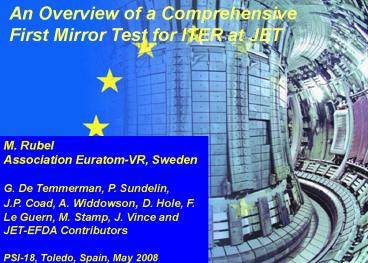An Overview of a Comprehensive - PowerPoint PPT Presentation
1 / 13
Title: An Overview of a Comprehensive
1
An Overview of a Comprehensive First Mirror
Test for ITER at JET
M. Rubel Association Euratom-VR, Sweden G. De
Temmerman, P. Sundelin, J.P. Coad, A. Widdowson,
D. Hole, F. Le Guern, M. Stamp, J. Vince and
JET-EFDA Contributors PSI-18, Toledo, Spain, May
2008
2
Background Origin of the Project
- All spectroscopy and imaging systems in a
reactor will be based on First Mirrors. - Degradation of mirror properties will directly
influence the quality of spectroscopy data. - A comprehensive mirror test in JET has been done
on request of the ITER Design Team. - Mirrors were exposed during 2005-2007 campaigns.
- The first set of mirrors was retrieved in 2007
shut-down.
3
Mirrors, Carriers and Exposure in JET
Tested mirrors 16 polycrystalline Mo and 16
stainless steel Mirror carriers 8 cassettes
with channels to place mirrors at different
distance from plasma, i.e. to simulate
different aspect ratio and resulting solid angle
Exposure time 126 600 s (35 h) including 96 900
s (27 h) of X-point operation
Conditions Large variety of discharge senarios,
conditioning shots, disruptions. Correspondence
8 ITER pulses scaled by energy input, to ITER
pulses 2/3 pulse scaled by expected divertor
fluxes (R. Pitts, PPCF, 47, 2005) Retrieved
mirrors 13 Mo and 16 (all) steel mirrors.
4
Location of Mirrors in ITER and JET
Minimum 80 First Mirrors Solid angle for particle
bombardment WPB 5x10-5 1.4 sr
5
Assembly in JET
6
Visual Inspection of Exposed Mirrors
Outer Wall 3E, Molybdenum Mirrors
1.5 cm
0 cm
4.5 cm
1.5 cm
3 cm
Note Deposition INCREASES with depth in the
channel.
7
Detachment of Deposits
Outer Divertor, Molybdenum
Outer Divertor, Steel
Divertor Base, Steel
This complex surface structure influences the
analyses.
8
Deposition on Mirrors Ion Beam Analysis
Outer Divertor, Molybdenum
Outer Wall, Molybdenum
General tendency On all divertor mirrors
deposition decreases with the depth in
channel. On the wall mirrors deposition first
increases with the depth in channel and then it
decreases.
Other results All co-deposits contain carbon,
deuterium and small quantities of beryllium and
13C. In many cases, layers are thicker than the
information depth with ion beam methods.
9
Reflectivity Measurements of Be and T
Contaminated Mirrors
- Cost-optimised solution for optical studies of
contaminated mirrors - Integrated sphere in the glove box.
- Photo-spectrometers outside the glove box.
10
Reflectivity of MirrorsGeneral Tendency for
Divertor and Wall Samples
Reflectivity change with depth in the channel
Outer Divertor, Stainless Steel
Outer Wall, Mo, unit with
shutter
initial
0 cm
1.5 cm
4.5 cm
- Main messages
- Most pronounced reflectivity loss in the
visible range. - Divertor Significant reflectivity loss
caused by deposition on all mirrors. - Wall Reflectivity loss for mirrors facing
the plasma is smaller than deep in the channel. - It is most probably related to instantaneous
erosion of deposits by CX flux. - No significant or clear difference between
mirrors protected and not protected by shutter.
11
Reflectivity of MirrorsComparison of Steel and
Mo
Reflectivity change with depth in the channel
Outer Divertor, Stainless Steel
Outer Divertor, Molybdenum
initial
initial
3 cm
3 cm
1.5 cm
0 cm
0 cm
1.5 cm
- Main message
- No significant differences between Mo and
steel.
12
Summary and Concluding Remarks (1)
- 29 test mirrors exposed in JET were studied with
optical and surface analysis methods. - The geometry of test units in JET partly
imitated the situation planned in ITER. - Results show consistently
- Decrease of deposition with distance from the
entrance to the channel in a cassette for all
divertor samples, - Increase of deposition with the depth in channel
on the main chamber samples. - No difference in the behaviour of molybdenum and
steel is observed. - The formation of flaking, dust generating layers
occurred on several divertor samples.
THE PERFORMANCE OF ALL EXPOSED MIRRORS HAS BEEN
DEGRADED. The same effects may be expected in
ITER after a few shots in carbon surrounding.
13
Summary and Concluding Remarks (2)
- The most urgent issue is to develop methods for
cleaning and/or mitigation of the plasma impact
on mirror performance. - The formation and detachment of layers is to be
taken into account when laser-induced cleaning
and controlled gas blow in vicinity of mirrors is
considered risk of dust generation and
mobilisation in diagnostic channels. - Replacement of mirrors using a mechanical
exchange cassette seems to be the most effective
method, though very challenging from the
engineering point of view. - Tentative concept The use of replaceable windows
for mirror protection may be considered for the
hydrogen phase of ITER. - Mirror test in JET will be continued during the
ITER-Like Wall operation in full metal
surrounding.































